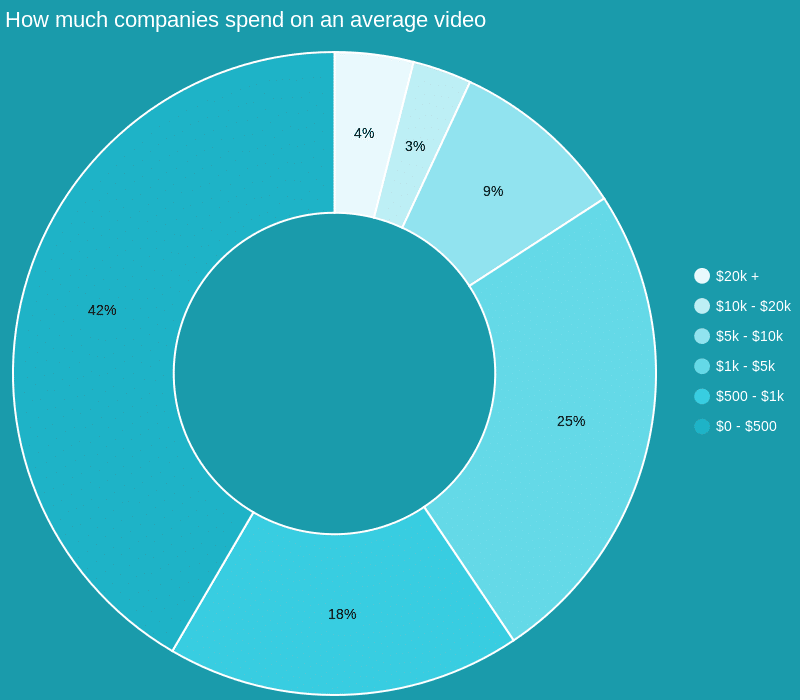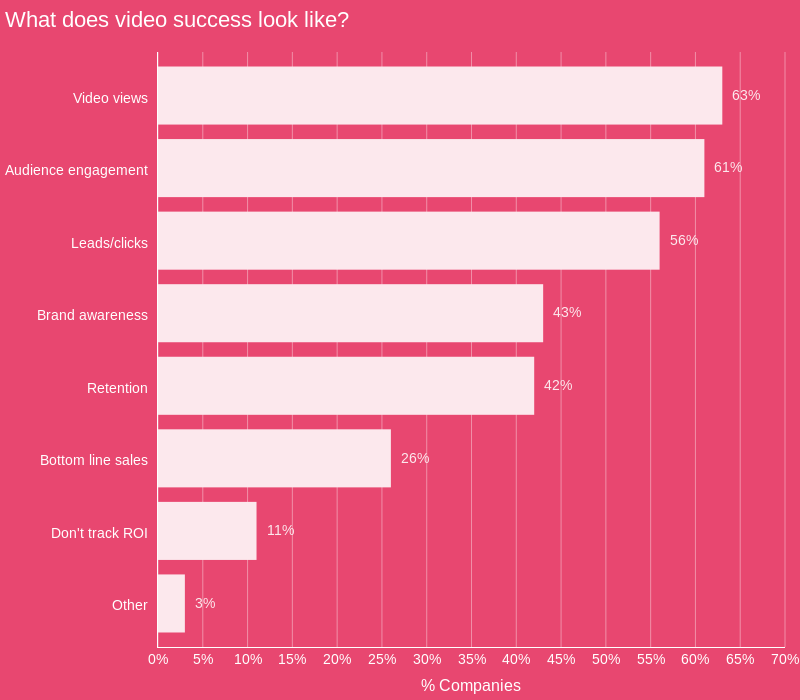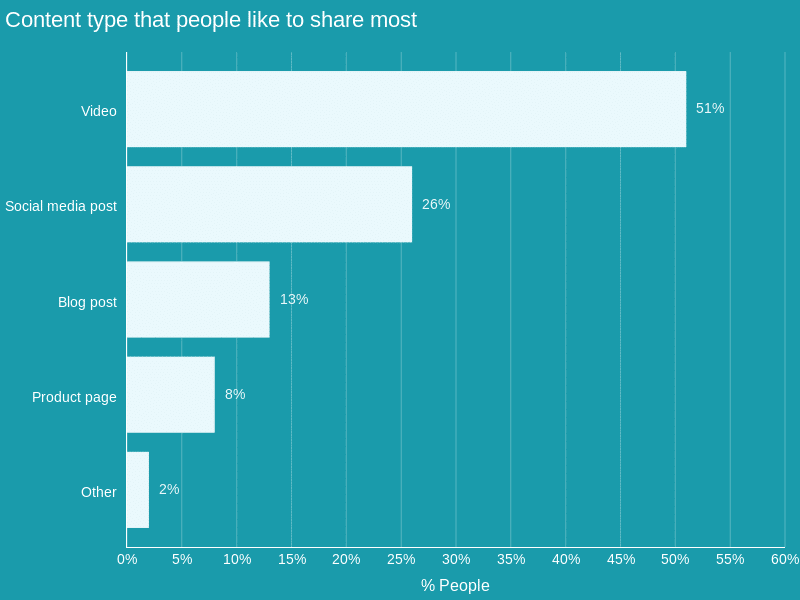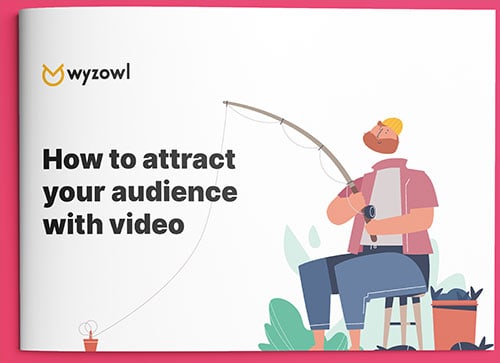Last updated on 9th January 2024
If you’re looking to enter the video marketing world, or level up your video strategy game in 2024, then this is the guide for you.
And, there’s no better time for it! According to our Video Marketing Statistics 2023, the highest EVER proportion of marketers (96%) continue to value video content as an important part of their marketing strategy.
While this number is high, it shouldn’t come as a surprise. Video marketing is a valuable tool for any business, with 92% of marketers agreeing that video gives them a good return on investment.
So, ready to find out more?!
Let’s jump into this complete video marketing strategy guide for 2024.
What is video marketing?
Video marketing is the process of using video to market your brand, product, or service. You can use video at any stage of the customer journey. For example, to raise brand awareness among potential customers, to convince leads to convert, and even to educate your current customers on how best to use your products.
Video content is extremely versatile and can be used across a variety of channels, from landing pages on your website, to social media, and email marketing.
Here’s an example of a marketing video we made recently for one of our clients, Pearl Certification:
Video content allows you to tell your story through captivating visuals, helping to draw audiences in and amplify your reach as a business. This makes videos one of the greatest tools for achieving your marketing goals.
The state of video marketing
Okay, let’s look at the facts. First, the financials. The amount businesses spend on a video marketing campaign varies a lot:

But most companies (75%) spend less than $5K on their video content.
Now, let’s look at the flipside of that: ROI. We’ve already covered above that a large majority of marketers believe video gives them a good return on investment, but let’s take a look at how that’s measured:

There are many different ways to gauge video strategy success. Most businesses tend to look at video views and audience engagement as a key indicator of success.
Finally, let’s take a look at consumers. Do they even want to see videos? The consensus is yes. And people like to share video content with their friends too:

Video is the content type that people like to share most, leading ahead of social media posts, blog posts, and product pages.
7 Benefits of video content
2. Increase brand awareness
3. Increase conversions and sales
4. Boost SEO
5. Deepen customer understanding
6. Build trust
7. Easiest content to share
1. People prefer video (over other content)
According to our Video Marketing Statistics 2022, most people (73%) would prefer to watch a short video when learning about a product or service. This compares to 11% who’d rather read a text-based article, website, or post, 4% who’d like to view an infographic, 3% who’d rather download an ebook or manual, 3% who’d rather attend a webinar or pitch, and 3% who’d like a sales call or demo.
2. Increase brand awareness
With more and more people watching and sharing videos, video content has the potential to reach a huge audience – and this can increase brand awareness, visibility, and recognition.
Additionally, because videos use audio and visuals, they can be more memorable – remember Dumb Ways to Die, anyone? – making it easier for people to recall your brand if they ever require services or products that match those mentioned in your videos.
3. Increase conversions and sales
Videos allow you to really showcase your products and services, making it easier for people to hit the ‘buy’ button and convert into paying customers.
According to our Video Marketing Statistics 2023, 87% of marketers said that video marketing has helped them increase sales. And that tracks with consumers too, because in the same survey we discovered that 89% of people have been convinced to buy a product or service after watching a video.
4. Boost SEO
Video content is great for SEO because it can increase the amount of time a person spends on your web page. An overwhelming 87% of marketers agree that video has increased dwell time on their website.
But it’s not all about dwell time, search engines are actively looking for video content now and they tend to favour sites that have videos on them. After all, videos do a great job of giving people the information they need in the fastest way possible – and that’s exactly what search engines want to do too.
5. Deepen customer understanding
If your business deals with complex or potential dry topics, video can be an excellent tool for breaking information down in an easy-to-understand but also entertaining way.
Not only that, educational videos that demonstrate how your product or service works will allow customers to get the most out of them, helping to build confidence, trust, and loyalty in your brand.
6. Build trust
Speaking of trust, video marketing is one of the best ways to build a connection with your audience.
You can do this in a number of ways. For example, telling your brand story. This can be especially powerful if you feature in the video yourself, or you show other people who work at your business.
In addition to sharing the stories of the people within your organisation, sharing the stories of your customers is also a great way to build trust. This allows potential customers to find someone to identify with – someone like them – and gain information about your business from another source.
7. Easiest content to share
Video content is so easy to share. If you see a video that makes you laugh, or tugs on your heartstrings, or simply showcases a cool new product, it’s simple to share that across pretty much every method of communication you use. In some cases, it only takes a couple of taps!
Other content, like blog articles, emails, and factsheets, aren’t so easy to share. This is definitely something to consider if you want to increase the reach of your marketing efforts.
5 Types of marketing videos (with examples)
2. Demo video
3. Testimonial video
4. Social media video
5. Video ad
1. Explainer video
Explainer videos are perfect for explaining to potential customers what’s so great and unique about your brand, product, or service.
Here’s an example we made for PetTech:
The video goes through current problems that viewers might be facing, before introducing PetTech as the solution and diving into all of the benefits of the product.
We call this a problem-solution-benefits storyline, and it’s a pretty foolproof way of creating an explainer video for your video marketing needs.
2. Demo video
Demo videos allow you to demonstrate how your software, platform, or app works. This can help you gain more new customers, but also educate current customers so that they get the best out of your product or service.
Here’s an example we made for BritBox:
This short video demonstrates a specific function within the platform – redeeming a gift card. And we created an animated version of the site instead of using real screenshots to give the video more longevity. This is a great idea if your software updates regularly and you don’t want your video content to quickly become out-of-date.
Another benefit of videos like this one is that it can help to reduce support queries by giving your customers an easy way to solve simple problems themselves. According to our Video Marketing Statistics 2023, 53% of marketers say video marketing has helped them reduce support queries.
3. Testimonial video
A testimonial video is a video that features an existing customer talking about their experience with your brand, product, or service.
It’s a great way to increase conversions with new leads and also to deepen your relationship with existing customers.
Here’s an example of one of our customer testimonial videos from Configit:
Testimonials are a crucial component of any strong video content strategy, especially when you consider that 9 out of 10 people trust what a customer says about a business more than what the business says about itself.
4. Social media video
Social media videos are videos made exclusively to share on social media. They’re typically short and shot in either a vertical or square format, in accordance with the requirements of most social media platforms.
Here’s an example of a social cut we made for MyIns:
This video ticks all of the boxes required for social media. It’s super short, engaging, and designed for mobile viewing.
Find out how we can help you with video production for social media!
5. Video ad
Video ads are videos that are created for advertising purposes. In other words, these videos are usually targeted to potential customers that fit your audience demographic. Video ads tend to be short and snappy. This is because viewers typically don’t tend to opt in to watch them, so they need to grab attention fast.
Here’s a video ad we made for GroupSocial:
This video is less than 60 seconds long and jumps straight in within the first 6 seconds to tell viewers that this is the fastest growing, most trusted influencer network in the world.
The first few seconds of any video ad are the most crucial because after this time viewers generally have the option to skip.
5 Stages of video production
2. Scripting
3. Pre-production planning
4. Production
5. Finishing touches
1. Briefing
The first step of any video marketing campaign is to gather all of your most important information together in a brief document.
Your brief should cover things like:
- The goal or aim of your video content
- The audience for the video
- Where the video will be used
- The key messages you want to convey
- And any notes on visual style
You could include more information in your brief, but these key components should give you enough clear direction and put you in a good place to begin the next stage of production.
2. Scripting
The next step is to take all of the raw information from your brief and reshape it into an engaging script.
It’s important for your script to be concise, entertaining, and aligned with the tone of voice and messaging that you typically use in your company’s marketing materials.
Even if you think you don’t need a script, write one anyway. This document will act as a blueprint for your video. It will help you determine the length (which is extremely important in the video marketing world) and understand what visuals you need to create.
It’s really important that you don’t underestimate the scripting stage of the process because a mistake on paper can be quickly and easily edited, but if you get into production and need to fix that same mistake, it could cost you a lot of time and money.
3. Pre-production planning
Yep, more planning. Trust us, this will all be totally worth it when it comes to actually animating your video, or shooting it if you’re creating a live action video.
The two processes are very different so we should probably split those up here.
Animation
For an animated video, the pre-production process involves creating a storyboard of each scene in your video and, along with this, designing all of the elements and characters that you want to use in your video.
You should also get a voiceover recorded, and possibly start reviewing music that you think would be a good fit for your video content.
Live action
For a live action video, pre-production planning involves things like scouting locations, acquiring necessary permits, hiring actors, and creating a shot list and production schedule.
You might also want to create a contingency plan for your shoot days that covers what you would do if an actor didn’t show up or if the weather caused a shooting issue, for example.
4. Production
This is where the magic happens! The production stage involves the actual filming of your video. Remember to think about everything inside the frame when shooting your footage and also try to capture additional shots and audio, just in case you need it at a later date.
With live action videos, you could also encapsulate post-production here. This is where you review and edit the raw footage to create your final product.
For an animated video, the production stage is much simpler. You take the graphics created by the designers in pre-production and animate those along with voiceover and a catchy soundtrack!
5. Finishing touches
Speaking of soundtracks, the little things really do matter when it comes to your video content. Simple touches like sound effects, interesting background elements, and even making sure your animated characters blink, are all going to elevate your video and make it seem more slick and professional.
How to create a successful video marketing strategy
2. Define your target audience
3. Plan your video(s)
4. Create!
5. Distribute your video
6. Analyse your video metrics
1. Define your goals
All successful video marketing strategies begin by defining goals and asking yourself what you want to achieve.
After all, the goals you have will determine the types of videos you want to create. For example, if you want to increase brand awareness then you should probably focus your video marketing strategy around video ads and social media videos. However, if you’re more interested in increasing brand trust and credibility then you’d be better off creating customer testimonial videos.
Clear goals will help you to define a clear video marketing strategy, and your goals will also come into play later when you want to measure the success of your video marketing campaigns.
2. Define your target audience
After you’ve defined your goals, you need to define your target audience. You probably have a good idea of your ideal customer already, but if you want your video strategy to be successful it’s important to really know them.
You need to understand their needs, preferences, pain points, interests, and motivations. You even need to understand how they speak, so that you can use similar language in your video content to make your marketing efforts relatable.
To gain this information you can conduct surveys using social media or more robust tools like SurveyMonkey. Or you could host focus groups with members of your target audience to gather feedback and insights that can help you build your video content strategy.
3. Plan your video(s)
Before you create your video content, it’s important to create a clear and robust plan. This will allow you to make sure everything remains on track when you’re focusing on video creation, so you can keep costs and delays to a minimum.
To plan your video, figure out the story you want to tell, who you want to target and how you want to get your point across. Once you know all of these things you can begin to work on a script.
Developing a compelling script is so important as it allows you to make sure you’ve hit all of the points you need to, and it will give you clear direction when it comes to creating your video(s), which is the next step!
4. Create your video in line with your requirements
The video creation portion of your video marketing strategy can be so exciting but it’s important to ensure that you stay focused and on track. This means sticking to your original budget and timeline as much as possible.
It’s also important to make sure you have everything you need to make your video content look amazing. This means using the best equipment you can afford, in terms of cameras, lighting, and audio tools.
You should also work with professionals, like voiceover artists and editors – you’d be surprised how big of a difference it can make when you source the right equipment and team.
5. Distribute your video
After working so long and hard on your video, you need to give it the best chance of being seen by as many people as possible. For this, you need a solid distribution plan.
The best tactic here is: the more, the better. Post your video in as many places as possible: emails, your website, all of your social channels, blog posts, YouTube, Vimeo. You should also look into using paid video ads to get your video in front of specific people that match the attributes of your target audience.
Additionally, it’s crucial that you optimise your videos for search engines. You can do this by incorporating relevant keywords in the title and description, and by also tagging your video with appropriate keywords. Check out this guide for more information: Video SEO: The Ultimate Guide.
6. Analyse your video metrics
In order to know if your video marketing strategy is working, you need to analyse your video metrics. These metrics include things like views, watch time, shares, click-through rates, and conversions. Anything that can be a key indicator of success for your video content.
In doing this, you can start to identify trends in audience behaviour that should give you some solid insights into how you can adjust your video strategy to achieve better results in the future.
Even if your videos perform better than you could’ve ever hoped, there’s always something to learn by analysing the metrics!
—
This 6 step strategy can – and should – be repeated for every video that you make. And, you’ll notice that the more videos you create, the smoother this process becomes.
How much does a marketing video cost?
The short answer to this is that it varies. You can make a marketing video for very little if you simply flip your iPhone towards your face and start recording. And while this may sound super basic and unprofessional, it’s not that uncommon.
Smartphone cameras are incredibly powerful and you can choose from tons of great (free) editing apps.
Here’s an example of a really simple video created by Krispy Kreme:
Social media videos like this definitely have a place in any well-rounded video marketing strategy as they’re quick and easy to make, meaning you can post them regularly.
However, for the most part, successful video marketing strategies should include professional-grade videos made by industry experts. Here’s another example from the same brand:
The price for professional marketing video ads like this can range from around $600 to $250,000!
We know this because we collected data from almost 250 explainer video companies to find out what the average price of a marketing video was. The answer: $8,457 (on average).
For more information on this, check out our study. We also go into detail on things like turnaround times and caveats.
Video marketing distribution
Distribution is so vital for your video marketing strategy that it’s worth looking at it in more detail. So, let’s take a look at the different places where you can distribute your videos…
1. Video sharing platforms
By this we mean sites like YouTube and Vimeo. These sites get an enormous amount of traffic every single day, so it definitely can’t hurt to have a presence there. Plus, you can use these platforms as video hosts if you want to embed your video elsewhere, such as on your website.
2. Social media
If you want people to see your videos, then you have to go where people watch videos. After sites like YouTube, that’s social media. Whether it’s Instagram, TikTok, Facebook, or even X (formerly Twitter), social media platforms are ideal for distributing your marketing videos (providing you meet the posting requirements of each platform).
3. Email
According to Statista, 347 billion emails are sent and received each day. This is 14 billion more than last year and it’s projected to climb even further next year. So, email marketing is still very much relevant and definitely has a place in any successful video marketing strategy.
4. Blog
Blogs and video content work hand in hand. For one, embedding videos in a blog post can boost SEO and increase dwell time on your site. Plus, sharing your videos with the readers of your blog is a great way to enhance engagement, boost brand exposure, and potentially drive new conversions.
People will often head to a blog post for information, and videos can be a valuable tool for conveying information in a quick, engaging, and memorable way.
5. Events
Videos are also excellent for events, whether it’s a trade show, award ceremony or conference. Having a video on show can really generate buzz around your brand and grab the attention of people passing by.
How to promote your video
Distribution is one thing, but you also need to make sure you promote your video as much as possible. This will ensure you get as many viewers as humanly possible, and that’s important to any video strategy. The more viewers you get, the more chances you have of reaching your goals.
With that said, here are 3 ways you can promote your video:
1. SEO optimisation
It’s important to make sure your video is optimised for search engines because search engines can’t see videos. They use written data – like keywords – to determine what results to show people. That’s why it’s so important to get high traffic, low competition, long-tail keywords in your video title and description.
2. Use hashtags
Hashtags are vital for social media promotion. One of the best ways for someone to find your video on social media organically is if you tag it with relevant hashtags. This could require some research, so take a look on social media and find out what hashtags appeal to your target audience.
3. Paid ads
Paid ads are a surefire way to get your videos in front of the right people. You get to define the specifics of the audience you want to target, including age, gender, interests, and basically anything else you can think of! Of course, the caveat here is that you typically pay for each view.
Measuring video strategy success
Possibly one of the most important parts of any great video marketing strategy is determining the success of your videos.
Video marketing success can be measured in many different ways, and it all depends on what your goals are. Here are some of the most common metrics to look out for:
1. Video views
This is pretty easy to understand and assess, with most video hosting sites showing the view count directly below the video.
Video views are a good marker for success if you’re looking to increase brand awareness.
2. Video shares
This is another simple metric. The number of times your video has been shared is an important thing to keep an eye on if you’re hoping to increase audience engagement and your brand’s reach.
3. Watch time
Watch time refers to how far through your video a viewer made it before they clicked away. Scrutinising watch time will help to inform your video marketing decisions in the future. You’ll be able to learn what video length your audience prefers and also spot if anything in particular makes them switch off.
4. Clicks
According to our Video Marketing Statistics 2023, 56% of video marketers say that leads and clicks are metrics by which they measure the ROI of their video content. Clicks can refer to how many people watched your video to the end and followed the instruction of the call to action (for example, booking a demo or visiting your website to find out more). This is the perfect metric to track if you want to increase conversions and sales.
Final thoughts
Okay, that was A LOT of information. Hopefully you feel more equipped to take on the weird and wonderful world of video marketing now.
A great next step would be checking out the competition. Watch some videos. See what the top brands are doing. Find out what your competitors are putting out there.
We’ve actually curated a huge list of some of the best explainer videos out there to help you get some inspiration. Check it out:







